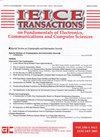A Small-data Solution to Data-driven Lyapunov Equations: Data Reduction from <i>O</i>(<i>n</i><sup>2</sup>) to <i>O</i>(<i>n</i>)
IF 0.4
4区 计算机科学
Q4 COMPUTER SCIENCE, HARDWARE & ARCHITECTURE
Ieice Transactions on Fundamentals of Electronics Communications and Computer Sciences
Pub Date : 2023-01-01
DOI:10.1587/transfun.2023map0010
引用次数: 0
Abstract
When a mathematical model is not available for a dynamical system, it is reasonable to use a data-driven approach for analysis and control of the system. With this motivation, the authors have recently developed a data-driven solution to Lyapunov equations, which uses not the model but the data of several state trajectories of the system. However, the number of state trajectories to uniquely determine the solution is O(n2) for the dimension n of the system. This prevents us from applying the method to a case with a large n. Thus, this paper proposes a novel class of data-driven Lyapunov equations, which requires a smaller amount of data. Although the previous method constructs one scalar equation from one state trajectory, the proposed method constructs three scalar equations from any combination of two state trajectories. Based on this idea, we derive data-driven Lyapunov equations such that the number of state trajectories to uniquely determine the solution is O(n).数据驱动的李雅普诺夫方程的小数据解:从<i> o>/i>(<i>n</i>< <sup>2</sup>)到<i>O</i>(<i>n</i>)
当一个动态系统的数学模型不可用时,使用数据驱动的方法对系统进行分析和控制是合理的。基于这种动机,作者最近开发了一种数据驱动的Lyapunov方程解决方案,它使用的不是模型,而是系统的几个状态轨迹的数据。然而,对于系统的维数n,唯一确定解的状态轨迹的数量是O(n2)。这使我们无法将该方法应用于具有大n的情况。因此,本文提出了一类新的数据驱动的李雅普诺夫方程,它需要较少的数据量。之前的方法从一个状态轨迹构造一个标量方程,而本文提出的方法从两个状态轨迹的任意组合构造三个标量方程。基于这个想法,我们推导出数据驱动的李雅普诺夫方程,使得唯一确定解的状态轨迹的数量为O(n)。
本文章由计算机程序翻译,如有差异,请以英文原文为准。
求助全文
约1分钟内获得全文
求助全文
来源期刊

CiteScore
1.10
自引率
20.00%
发文量
137
审稿时长
3.9 months
期刊介绍:
Includes reports on research, developments, and examinations performed by the Society''s members for the specific fields shown in the category list such as detailed below, the contents of which may advance the development of science and industry:
(1) Reports on new theories, experiments with new contents, or extensions of and supplements to conventional theories and experiments.
(2) Reports on development of measurement technology and various applied technologies.
(3) Reports on the planning, design, manufacture, testing, or operation of facilities, machinery, parts, materials, etc.
(4) Presentation of new methods, suggestion of new angles, ideas, systematization, software, or any new facts regarding the above.
 求助内容:
求助内容: 应助结果提醒方式:
应助结果提醒方式:


